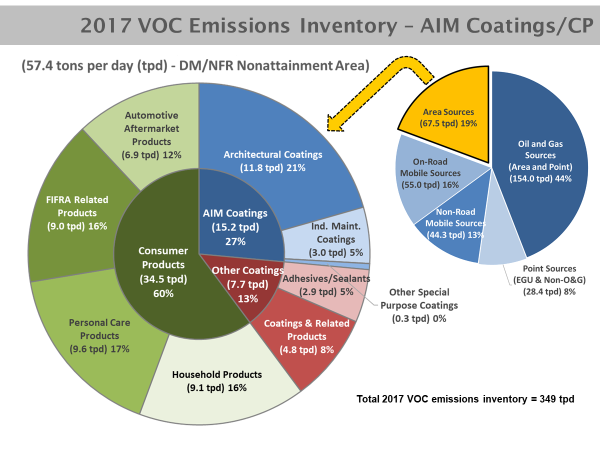Overview
In 2015, the Regional Air Quality Council (RAQC) began convening committees to evaluate options to reduce ozone in the Denver Metro/North Front Range (DM/NFR) Area. As part of the RAQC’s committee strategy review process, evaluation of options to reduce emissions of volatile organic compounds (VOC) from consumer products and Architectural and Industrial Maintenance (AIM) coatings was identified. The Stationary and Area Sources Subcommittee determined this area to be a top priority. As a result, this literature review was commissioned to evaluate what regulations currently exist related to these product types and what opportunities may exist in Colorado to minimize emissions from this sector.
The two types of product categories evaluated as part of this literature review were consumer products and AIM coatings. Consumer products are items that are purchased at the store and are found around our homes and businesses. They range in their appearance and use, from hand sanitizer to the all-purpose cleaner used to clean countertops, but the one thing they may have in common is that they often contain and release VOCs when they are used, which is a precursor to ozone formation. Similar to consumer products, architectural coatings, sometimes referred to as AIM coatings, includes paints and stains that are used around homes and businesses, and also often contain VOCs. In Colorado, AIM coatings and consumer products will comprise 17% of the emissions inventory in 2017.
To address VOC emissions from this category, the RAQC and the Colorado Air Pollution Control Division (APCD) have been investigating the feasibility of adopting model rules crafted by the Ozone Transport Commission (OTC) based on California Air Resources Board (CARB) regulations.
Regulation 21, the Low VOC Architectural and Industrial Maintenance (AIM) coatings and consumer products rule, was approved by the Air Quality Control Commission and will go into effect May 21st, 2020.

RAQC Final Reports
Market Survey (August 2017)
Literature Review (June 2016)
Presentations
Low VOC and AIM Background and Proposed Rule (May 2019 Board Meeting, RAQC)
Low-VOC Survey Overview (Sept. 2017 S/A Source Committee, RAQC)
Low-VOC Literature Review Overview (Dec. 2016 S/A Source Committee, Takushi)

